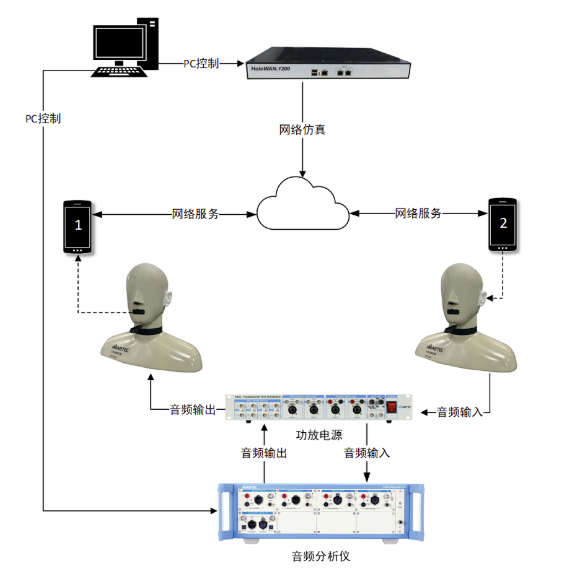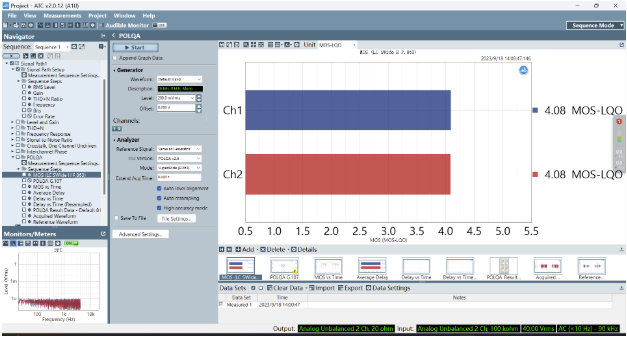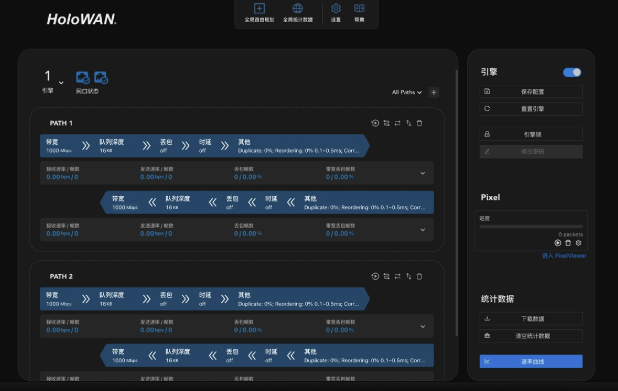1. Solution Overview
The core objective of this test solution is to evaluate the audio transmission quality of instant messaging software during usage through POLQA (Perceptual Objective Listening Quality Assessment). As instant messaging software transmits signals over mobile networks, this solution employs a network impairment emulator to introduce various network effects (e.g., jitter, latency, packet loss) into the transmission link. This simulates real-world network conditions, enabling accurate measurement of audio transmission quality in practical scenarios.
POLQA is a psychoacoustic model-based algorithm that mimics the human auditory system’s perception of sound. Its workflow includes filtering, time alignment, sampling rate estimation, perceptual modeling, and scoring, ultimately generating a POLQA score mapped to a Mean Opinion Score (MOS). This solution uses an audio analyzer to obtain MOS results with one click. It also includes comprehensive test equipment and accessories to help users quickly set up and execute tests.
2. Test Block Diagram
The solution centers on two core devices: an audio analyzer and a network impairment emulator. The audio analyzer measures MOS and other audio parameters, while the emulator simulates network impairments (e.g., jitter, delay, packet loss, bit errors). The test block diagram is shown in Figure 1:

Figure 1 Test Block Diagram
Test Procedure:
The link in Figure 1 uses smartphones installed with the instant messaging software as Devices Under Test (DUTs). This example tests audio transmission quality from Phone 1 to Phone 2 (the reverse link test method is similar).
Ensure stable audio connectivity between DUTs. Connect the audio analyzer to an amplifier power supply, then to two artificial heads (for audio output/capture). Integrate the network impairment emulator into the DUTs’ network environment. Both instruments are controlled via a PC. Before testing, use the "DUT Delay" function in the audio analyzer to measure transmission link delay.
Activate Phone 1’s microphone and output test audio to Phone 1 via an artificial head. Activate Phone 2’s speaker and capture output audio via another artificial head. Analyze the captured audio to obtain the MOS for the current link.
Adjust the network impairment emulator settings to simulate different application scenarios. Conduct multiple tests to measure audio transmission quality scores under various conditions.
Figures 2 and 3 show typical interfaces of the audio analyzer and network impairment emulator:

Figure 2 Audio Analyzer POLQA Test Interface

Figure 3 Network Impairment Emulator Interface
3. Solution Advantages
● Supports POLQA test option (based on ITU-T P.863), using POLQA 3.0 algorithm to subjectively evaluate voice quality for broadband voice devices or acoustically coupled systems. Compatible with ultra-HD voice, 4G, 5G, VoLTE, and VoNR technologies.
● POLQA 3.0 is optimized for complex noise environments and advanced voice enhancement technologies. It provides full-bandwidth MOS scoring, improved time alignment, and noise handling, meeting 5G and future voice technology requirements.
● High-performance hardware test equipment. Residual THD+N (20kHz BW) typically < −120 dB (1kHz, 2.0V), making it ideal for audio product R&D.
● Devices are software-controlled, support automated test report generation, and export reports in multiple formats for easy result storage.
● The audio analyzer offers comprehensive test capabilities. Beyond subjective audio quality evaluation, it supports metrics like SNR and frequency response, meeting testing needs for earphones, speakers, microphones, and other audio products.
● The network impairment emulator’s single engine can emulate ≤15 independent virtual links, supporting multi-task parallel testing. Features flexibly configurable delay/jitter, diverse packet loss/bit error modes, and packet classifiers.
● Supports recording network bandwidth, latency, and packet loss rate over time. Recorded data can be imported for playback to accurately replicate real-world network conditions.
● Provides fully open APIs for seamless integration with test automation tools, improving efficiency and productivity.
● Comprehensive test equipment and accessories included for rapid test environment setup.
4. Core Product Specifications

Figure 4 Audio Analyzer A10
● Standard Interfaces: SPDIF/TOSLINK/AES/EBU digital interfaces.
● Expandable Interfaces: BT/HDMI/I2S/PDM.
● Complete and powerful electroacoustic analyzer functionality.
● Codeless automation and comprehensive API interfaces.
● Supports LabVIEW, VB.NET, C#.NET.
● Automatically generates test reports in multiple formats.
● More than 60 test functions, including oscilloscope, spectrum analyzer, and continuous fast sweep.

Figure 5 Network Impairment Emulator
● Max. bandwidth per engine: 1000 Mbps.
● Max. virtual links per engine: 15.
● Packet processing capacity: 0.3 Mpps.
● Plug-and-play, no software installation required. Rapidly configure impairments via Web GUI.
● Diverse packet loss/bit error modes and packet classifiers.
● Open APIs support integration with test automation tools to enhance efficiency.